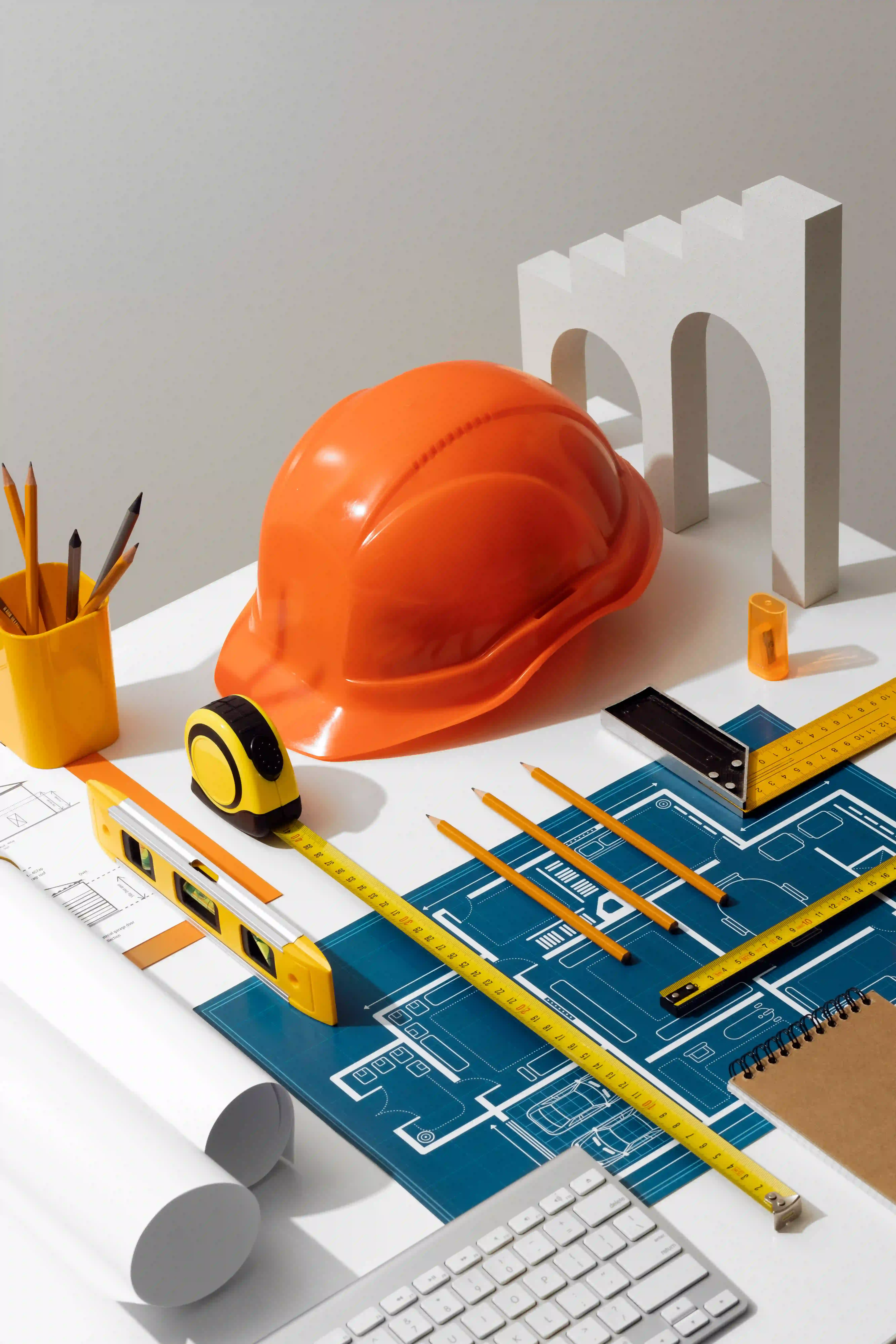
Millwork shop drawings are crucial in Architectural and Interior design. It provides precise, production-ready CAD drawings for furniture, cabinets & decorative moldings.
These drawings guide the fabrication process, ensure accurate craftsmanship, reduce errors, and enable smooth communication between architects, designers & craftsmen.
What is an Architectural Millwork Shop Drawing?
An architectural millwork shop drawing is a detailed diagram or plan created by architects or drafters to communicate specific design instructions for custom millwork components.
These drawings provide –
- Precise measurements,
- Material specifications and
- Assembly details for items like cabinets, doors, windows & trim pieces.
Unlike general architectural plans that provide an overview of the entire building, millwork shop drawings zoom in on specific woodwork elements. It ensures they align seamlessly with the overall design vision and meet quality standards.
These drawings provide the dimensions, materials, joinery techniques, finishes & other specifications that are essential for the accurate production of the millwork.
Role of Millwork Shop Drawing in Construction
Millwork shop drawings play a crucial role in ensuring the successful execution of custom woodwork in the construction process.
The millwork shop drawings provide the between the design phase and the actual construction, providing a comprehensive and precise representation of how the components should be manufactured and installed.
The millwork shop drawings guide craftsmen, carpenters, and manufacturers to ensure the final output aligns with the architect’s vision.
The millwork shop drawings are more important in construction for several reasons:
1. Detailed Instructions
- Precise Measurements: Provides exact dimensions for each piece.
- Material Specifications: Details the type and quality of materials needed.
- Assembly Instructions: Outlines how to put together custom elements like cabinets and moldings.
2. Minimizing Errors
- Clear Guidelines: Offers step-by-step directions to follow.
- Reduces Mistakes: Helps craftsmen avoid common errors.
- Minimizes Waste: Ensures materials are used efficiently.
3. Facilitating Communication
- Aligns Teams: Ensures architects, designers, contractors, and craftsmen are on the same page.
- Clarifies Design: Provides a clear reference for what needs to be built.
- Streamlines Process: Facilitates smoother coordination between different parties.
4. Enhancing Quality
- Detailed Drawings: Shows joinery and installation methods in depth.
- Maintains Standards: Ensures the final product meets design and quality expectations.
- Consistent Results: Helps achieve a high level of craftsmanship and finish.
Features of Millwork Shop Drawing
The features of the millwork shop drawings provide several components, they are
1. Detailed CAD Drawings
Millwork drawings provide the exact measurements, dimensions, and geometric representations of each component such as cabinets, doors, window moldings, and trim. These drawings convey the design intent and guarantee precise replication during fabrication.
2. Material Detailing
Millwork drawing gives the details of wood types, veneer, finish, hardware specification, and other materials required for each component. This ensures consistency in quality and appearance and helps craftsmen in selecting the materials for each profiles.
3. Assembly Instructions
These instructions help to understand each step of how to assemble and install the millwork components. They provide specifics on joinery techniques, fastening methods, and assembly diagrams to ensure craftsmen construct the components accurately.
4. Finish Details
Millwork shop drawing, including the profile material surface finishes, like prime, stains, and sealants to be applied to the woodwork. These details show that the final product meets aesthetic standards and final output.
5. Hardware and Equipment
These drawings provide detailed information about the equipment such as position, dimension, size, and type of the hardware. The location of hardware such as hinges, handles, knobs, locks, or any other decorative elements to be incorporated in the millwork.
Benefits of Millwork Shop Drawings
1. Clearly Visualize Your Design:
- See exactly how your design will look before it’s built.
- It helps you avoid surprises & ensure the design matches your vision.
2. Easily Identify Potential Issues:
- Spot and address problems early.
- Avoids costly mistakes and delays.
3. Accurately Communicate Your Vision:
- Ensures everyone (contractors, craftsmen, etc.) is on the same page.
- Leads to smoother project execution & fewer misunderstandings.
4. Precisely Plan Materials and Costs
- Efficiently plan the materials needed and get accurate cost estimates.
- Helps you stay within budget and avoid unexpected expenses.
5. Confidently Meet Deadlines
- Provides a clear roadmap for construction.
- Keeps the project on track and ensures deadlines are met without stress.
6. Enhance Overall Project Quality
- Focus on every detail from the start.
- Achieves a higher quality finish that meets or exceeds expectations.
7. Easily Customize Designs
- Flexibility to tweak and adjust designs.
- Ensures the design perfectly matches your vision and requirements.
8. Seamlessly Integrate with Existing Structures
- Ensures millwork fits flawlessly with the existing architecture.
- Creates a cohesive look and integrates smoothly with current structures.
9. Reduce Onsite Errors
- Minimize mistakes during installation with precise measurements.
- Saves time and resources by avoiding rework.
10. Smoothly Coordinate with Other Trades
- Better collaboration with trades like plumbing and electrical.
- Ensures everything fits together seamlessly and avoids conflicts.
11. Consistently Achieve High Standards
- Maintain a consistent level of quality throughout the project.
- Leads to a polished final result & upholds high craftsmanship standards.
12. Efficiently Manage Project Timelines
- Plan tasks in advance and keep the project running smoothly.
- Ensures timely completion and effective project management.
What Is Included In Millwork Shop Drawings?
Millwork drawings are used to provide detailed information about the profiles for better installation in the field. It acts as a tool for communication between the designers and manufacturers. The millwork drawings include:
Dimensional Information: Precise measurements that ensure the millwork components fit perfectly within the designated space. This involves both overall dimensions and specific measurements for individual parts like panels, moldings, and trims.
Material Specification: The millwork drawings help to identify the types of wood or other materials used in the profiles. This includes details such as wood species, grade, finish, and any special treatments or coating needed.
Profiles and Mouldings: Millwork typically includes detailed profiles and moldings that enhance the decorative aspects of architectural features like doors, windows, and cabinetry. Shop drawings outline the precise profiles and measurements of these moldings to guarantee uniformity and precision during fabrication.
Elevations and Sections: Elevations and cross-sections provide the profile’s additional details. This also shows how the profile will look and how the profile or component relates to the other elements within the space.
Construction or Installation method: The millwork drawings provide the profile’s construction details and installation method to help the manufacturer and contractors install them in the field without any errors.
Conclusion
Millwork shop drawings are essential in construction projects, offering detailed and precise blueprints for crafting custom wooden elements. They ensure accuracy, improve communication among stakeholders, and streamline the fabrication process. By providing clear guidance and specifications, these drawings play a vital role in realizing architectural designs, ensuring the final product meets the highest standards of quality and craftsmanship.
Frequently Asked Questions
1. What are millwork drawings?
Millwork drawings are detailed plans that specify the dimensions, materials, and assembly instructions. It is for custom woodwork elements like cabinets, doors, and moldings in a construction project.
2. What is millwork in construction?
Millwork refers to the custom woodworking elements in a construction project. Eg. cabinetry, moldings, and trim, typically made from wood or wood-like materials.
- What is the shop drawing in a construction project?
Shop drawings are detailed diagrams provided by contractors or manufacturers. It shows how specific components will be built or installed. This includes dimensions, materials, and assembly instructions.
- What is the difference between drawings & shop drawings?
Drawings typically refer to architectural plans or blueprints that outline the overall design.
Shop drawings are detailed, construction-specific plans. It focuses on how particular components will be fabricated and installed.
- How to read millwork shop drawings?
To read millwork shop drawings, start by reviewing the overall layout. Then examine the detailed measurements, material specifications, and assembly instructions to understand how the components fit together.
- What is a millwork shop?
A millwork shop is a specialized workshop where custom woodwork elements are designed, manufactured & assembled according to specifications in construction projects.
- What is another name for millwork?
Another name for millwork is “custom woodworking,” which encompasses various wood components & decorative elements in a construction project.


